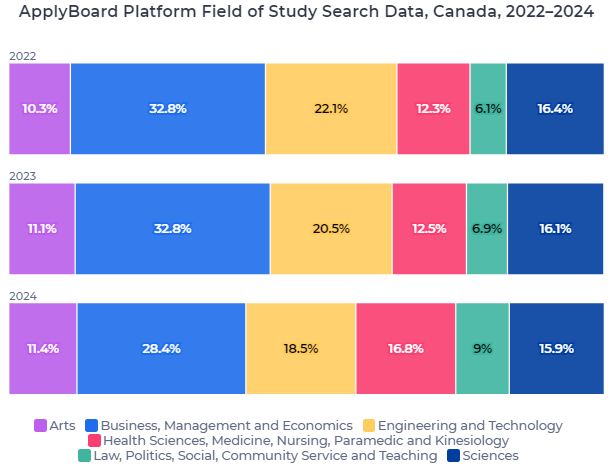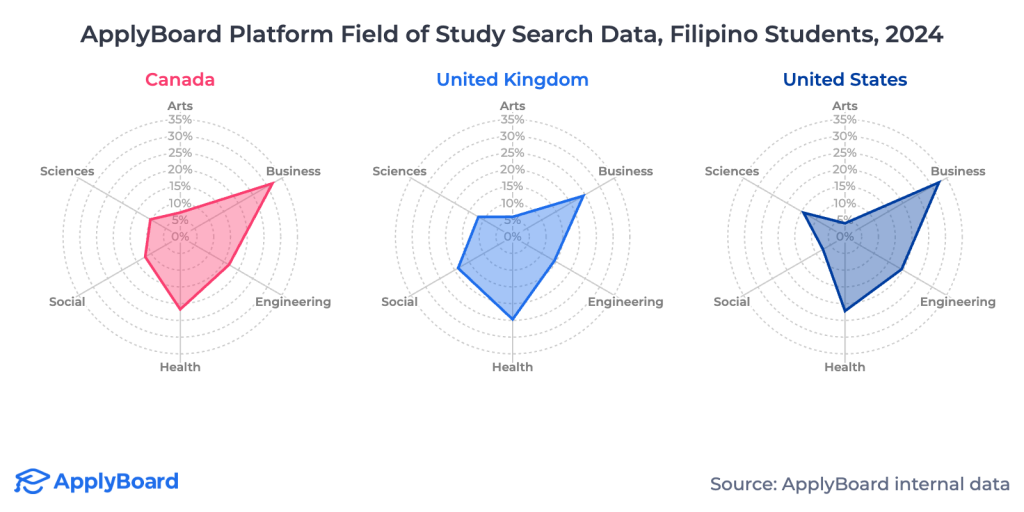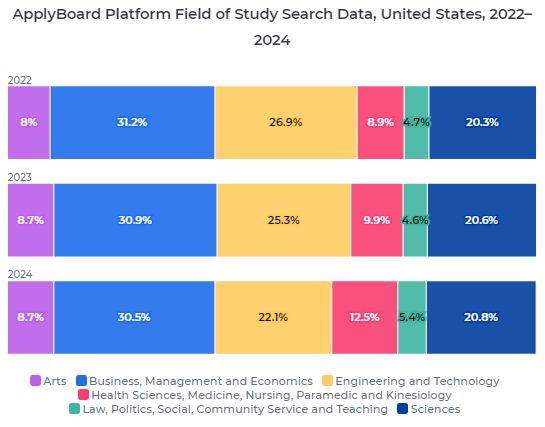OVER the past few years, millions of different students have used the ApplyBoard platform to search for international study programs.1 For many of these students, searching for programs in Australia, Canada, Ireland, the United Kingdom, and the United States on our platform is one of the first steps in their study abroad journey. This proprietary search data gives us a leading indicator of changing student preferences, empowering us to help students achieve their education and career goals.
Today, we’re examining how international students’ program searches for Canada, the US, and the UK shifted in 2024. Last year was a tumultuous time for unprecedented policy changes, and shifting policies can have a major impact on student program preferences. Discover how these student preferences adapted in 2024 and how institutions could adjust for 2025.
What Canadian fields of study did international students search for in 2024?
In 2024, shifting student interests reshaped program demand in Canada. While policy changes influenced overall student mobility, key international student populations showed strong engagement with programs that align with Canada’s long-term workforce needs. This contributed to notable growth in search volumes for health fields, as well as continued interest in engineering and technology, and sciences fields.
Here’s how student searches evolved across different fields this year:

The proportion of searches for Canadian health programs jumped over four percentage points in 2024, compared to the previous year. More students entering health fields would be a tremendous boon to the country’s national wellbeing, as the shortage of doctors and nurses in Canada is expected to reach 78,000 and 117,600, respectively, by 2031.
This rising interest in health programs was reflected across many of Canada’s largest international student populations in 2024. For Indian students, 17% searched for programs in this field, up from 13% the year before. The share of Ghanaian and Nigerian students exploring health programs also rose, reaching 21% and 20%, respectively—both increasing by five percentage points. Meanwhile, strong demand continued among Filipino students (22%), while interest among Brazilian (14%) and Sri Lankan (10%) students nearly doubled year-over-year.
How student interest shifted across Canadian fields of study
The growing interest in health fields, along with a two percentage point rise in searches for law and other social-focused programs, led to a smaller share of searches for business, engineering and technology, and sciences compared to 2023. However, as demand for STEM talent continues to drive workforce needs, many student populations have increased their interest in engineering and technology and the sciences—highlighting ongoing opportunities for institutions to attract top talent in these fields:

More than 20% of Bangladeshi, Brazilian, Chinese, Mexican, and Nepalese students searching for Canadian programs did so for the engineering and technology field. The field was even more popular among Colombian and Sri Lankan students, accounting for nearly one in four searches.
Canadian science programs also attracted growing interest from several key student populations in 2024. Brazilian and Filipino students doubled their share of searches compared to 2023, reaching 14% and 10%, respectively. Over 20% of Bangladeshi students explored this field, making them one of the cohorts most engaged with Canadian sciences. Interest also grew among Chinese, Colombian, Mexican, Nepalese, and Sri Lankan students, with searches for Canadian science programs rising by at least three percentage points in each group.
These trends signal an opportunity for Canadian institutions to attract more international students in high-demand fields. Highlighting career pathways, research opportunities, and work-integrated learning in health, engineering and technology, and the sciences can help institutions align with student interests and workforce needs.
What US fields of study did international students search for in 2024?
Unique search volume for the United States on the ApplyBoard platform doubled in 2024, compared to 2023. These gains were unsurprising, as the US saw the largest increase in positive global news sentiment about the four major Anglophone destinations during this period. Yet, even with this surge in interest, the distribution of searches across fields of study remained largely stable compared to previous years:

The biggest shift was in engineering and technology, where the share of searches fell by nearly three percentage points. Those searches generally went to health fields, which were up by over two percentage points, and social-related fields, up nearly one percentage point.
Sciences accounted for nearly 21% of all US-centric searches in 2024, higher than any of our other destinations. This reflects the US’s long-established reputation as a hub for STEM-related studies.
Field of study search trends among US-bound students
Search interest from students in Bangladesh, Ghana, Nigeria, and Sri Lanka doubled in 2024 compared to the previous year. On top of that, Pakistani searches for US programs tripled while Nepalese searches quadrupled.
Health fields saw the highest interest from students from Nigeria (20%), Ghana (20%), and India (13%). In fact, this field’s share of searches from Nigerian and Ghanaian students rose seven and five percentage points compared to the previous year. Additionally, the share of searches for health fields increased for eight of the nine student populations in 2024, compared to the previous year.
The sciences were a key focus across all nine student populations, accounting for at least 15% of searches in each group. Students from Nepal (22%), Pakistan (22%), and India (21%) led the way with the highest share of science searches. Other notable trends include shifts in Brazilian student interests, where the proportion of science searches doubled from 2023, and Iranian program preferences, where one in four searches were also for the sciences field.
Despite its slight overall decline in student interest, engineering and technology remained a top choice for many international students. Sri Lankan (29%), Pakistani (24%), and Bangladeshi (23%) students showed the highest levels of interest in this field, though at least 17% of the remaining six key populations also searched for engineering and technology programs.
As international student interest in STEM fields remains strong and demand for health programs grows, US institutions have an opportunity to reinforce their strengths in these areas. Strengthening industry partnerships, expanding hands-on learning experiences, and supporting post-graduation employment pathways can help attract and retain top international talent.
